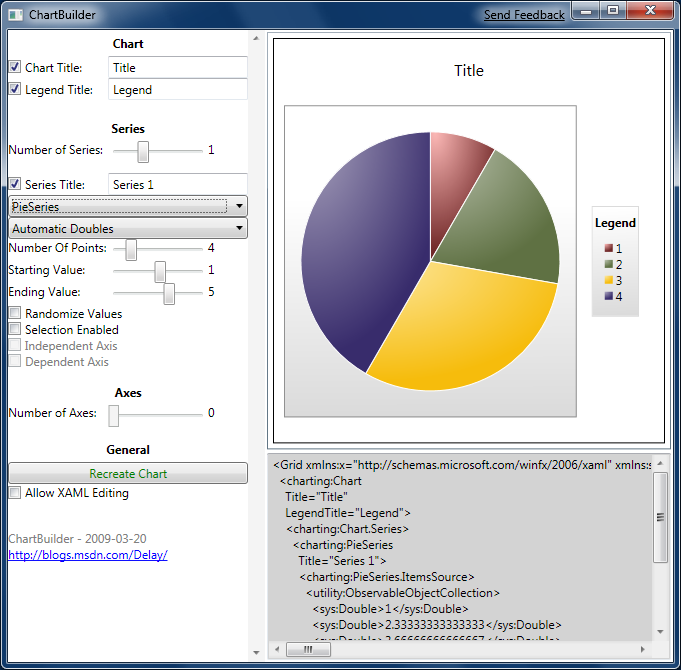Supporting the unsupported [Two fixes for the unofficial WPF Charting assembly!]
In my last post I described a few updates I made to my ChartBuilder sample/application/learning tool for the March 09 release of the Silverlight Toolkit. As usual, I posted the complete source code to ChartBuilder for interested parties to download and play around with. But this time around I also took the opportunity to showcase a WPF version of ChartBuilder that shows off an unofficial version of Silverlight Charting for WPF. Along with a WPF-based project file for ChartBuilder, I included a private build of the WPF Charting assembly that it compiles against.
I cautioned readers that WPF Charting was completely untested, but it was my not-so-secret hope that some of you would take the opportunity to play around with WPF Charting and give us some early feedback. And you did! :)
In addition to a known issue I describe in the previous post where dynamically added or removed DataPoints don't always complete their show/hide animations, kind reader abrien reported an additional problem causing a KeyNotFoundException during certain updates to a PieSeries's ItemsSource property. Then he/she went even further to create a CodePlex work item with a simple sample project demonstrating the problem! (Which is fantastic bug reporting, by the way!)
Now, before I go further, let me take this opportunity to reemphasize that neither of these problems is present in Silverlight Charting; they exist only in WPF Charting and are there because we've done absolutely no testing of WPF Charting due to a profound lack of time or resources. In fact, this is probably a good time to remind everyone of the warning I gave last time:
Warning: We have done absolutely no testing of the WPF Charting bits and if you decide to pull them out of the source code download and play around with them, then you do so at your own risk!
Okay, enough scare-mongering! :) The truth is that we'd love for people to be able to start experimenting with WPF Charting. So while the known show/hide problem was already bothering me, finding out about an exceptional condition arising from a fairly simple ChartBuilder scenario was downright unpleasant...
I spent some time over the weekend looking into both of these issues to see if I could identify the problem and perhaps fix it without too much fuss. And the good news is that I believe they're both fixed now! [After no small amount of frustration along the way... :) ] As it happens, both problems result from fairly subtle Storyboard behavior differences between Silverlight and WPF - though I'm happy to note the fixes I made are not platform specific. In other words, it's possible to write the exact same code on both platforms and have it work correctly on both platforms. It's just the code we started with wasn't that code... :(
I'm optimistic that both of these problems are behind us. And what's more, the fixes are already checked into our source control system for inclusion in the next release of Charting. But I don't want early adopters of WPF Charting to have to wait that long, so I've gone ahead and updated the WPF Charting assembly in the ChartBuilder download to include both of these fixes! If you're already playing around with WPF Charting, please take a moment to upgrade to the new version of System.Windows.Controls.DataVisualization.Toolkit.dll (file version 3.0.30324.1808) from the ChartBuilder download link below. And if you don't care about WPF Charting, then please don't worry about any of this - there are no other changes to the files in the download archive.
Our thanks go out to everyone who has given Silverlight Charting a try - and special thanks to our WPF Charting pioneers for their passion, feedback, and patience!
Please click here to download the complete ChartBuilder source code.
